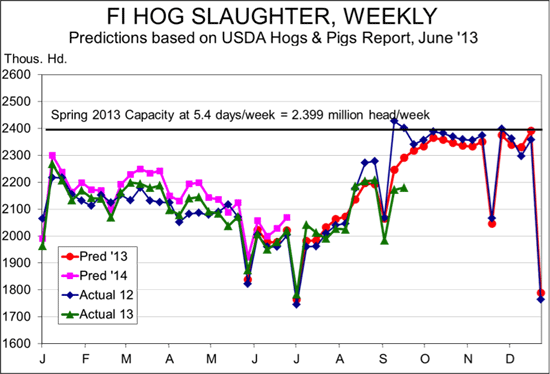



Hog Slaughter Continues to Fall Short
US - Hog supply is still on everyone’s mind as weekly slaughter totals continue to run well below year-ago levels. I addressed this topic last week but I think it bears attention again this week, writes Steve Meyer in his weekly Market Preview as published on National Hog Farmer magazine.As can be seen below, this is the fourth week of the last five in which slaughter has been FAR LOWER than one year ago. The last two weeks have seen runs 10.5 per cent and 9.2 per cent lower than in 2012. Last year, of course, producers were trying to move pigs to market to reduce feed costs. The result was significant increases in hog slaughter and lower – or at least not higher as normally is the case in September – market weights. So, the year-ago numbers are a high mark indeed for comparison.

But recent slaughter has been significantly lower than "expected" as well. In fact, slaughter figures the past three weeks have fallen short of my forecast numbers by 84,000, 73,000 and 111,000 head, respectively. Does this mean hog numbers in the June report are wrong? Not necessarily. Before Labor Day, actual slaughter had been within 0.1 per cent of my forecasts, based on the June report and some adjustments for last year’s unusual conditions. It would be pretty unusual for a report to go from dead-on accurate to badly inaccurate in the course of a few weeks.
Three possibilities seem reasonable. First, hotter weather and the corn from the very, very bottom of everyone’s bins very likely slowed performance in August. The shortfalls in slaughter seem large even for this factor but we need to remember that we started using the 2012 corn crop early and have had to make it stretch late. The issues of late-season corn quality and palatability could be especially acute this year.
The second factor is, as was addressed last week, lousy packer margins. I have always equated the size of Saturday hog slaughter to packer margins. Saturday operations are critical in holiday-shortened weeks to keep hogs moving and keep product supplied to end users. But Saturday operations in non-holiday weeks are, for many packers, opportunities. If profits are good, they will add hours even when the labor for those hours costs time-and-a-half. And those opportunities usually grow past Labor Day when hog supplies are generally higher.








